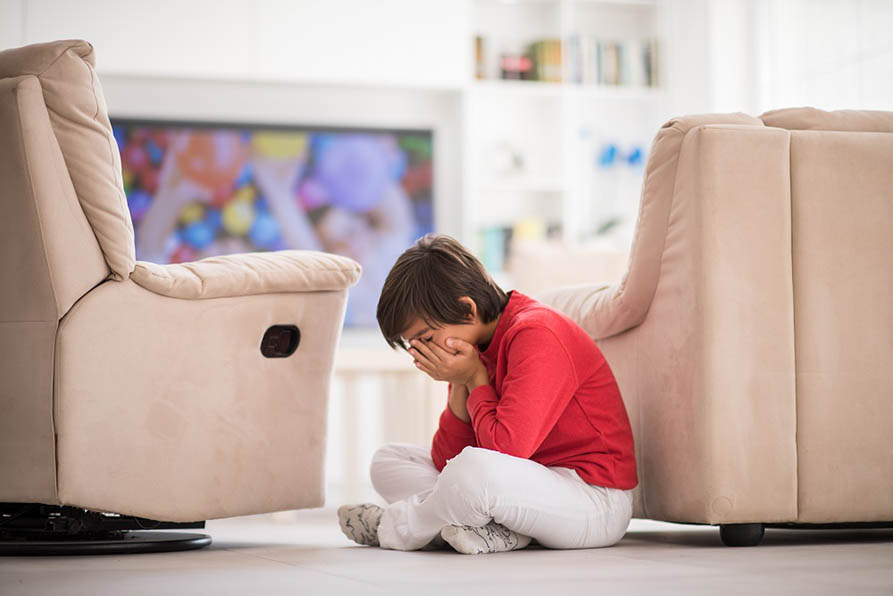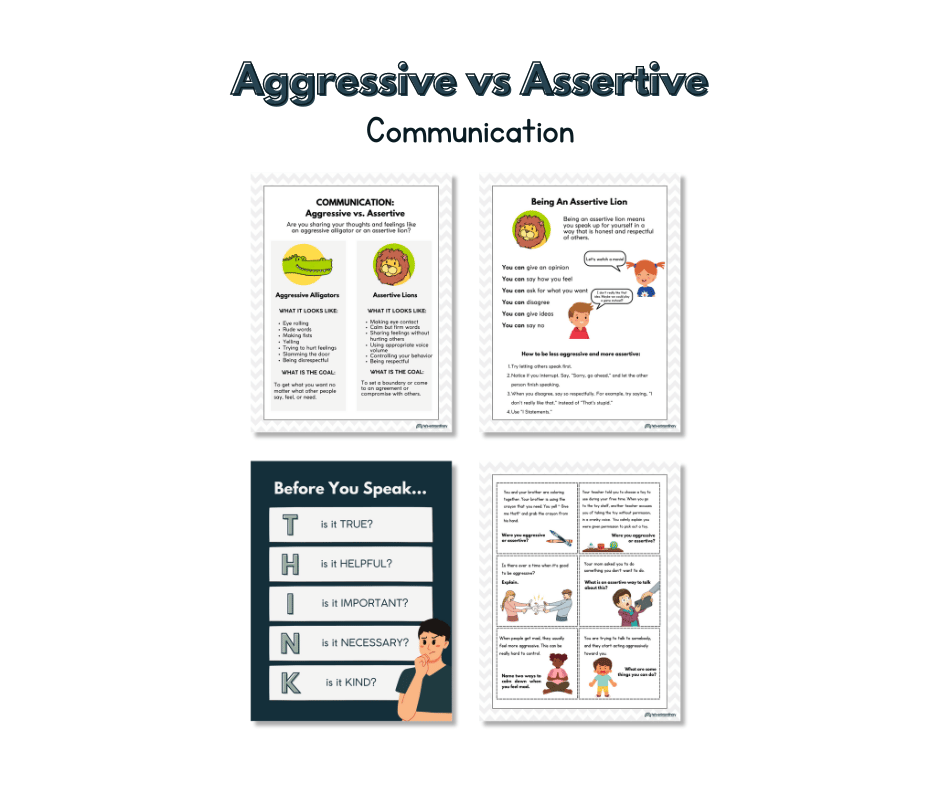18 Effective De-Escalation Strategies For Defusing Meltdowns
What’s inside this article: An overview of the escalation cycle, how the brain functions during different emotional states, and evidence-based, supportive de-escalation strategies that are used in non-violent crisis intervention to compassionately help your child during meltdowns and outbursts.
As a parent, it’s important to know some safe and helpful de-escalation strategies for meltdowns.
Sometimes, when children become extremely overwhelmed or they’re experiencing sensory overload, they have a meltdown where they become so dysregulated that their bodies react automatically.
This is an automatic nervous system response and not something our kids can consciously control.
These situations are stressful and overwhelming for everyone involved and could potentially lead to safety risks for both your child and bystanders.
Knowing some de-escalation strategies will help you provide a supportive response to your child during these challenging moments.
The Escalation Cycle
Although meltdowns may seem unpredictable or like they happen out of nowhere, there is a clear pattern that happens before, after, and during a meltdown.

The escalation cycle is something I talk about in a lot of my posts, and familiarizing yourself with each of the stages and the different strategies for each stage will help you not only respond to meltdowns but to learn to support your child proactively, reducing their frequency.
Equally important to being able to identify each stage of the escalation cycle is knowing which non-violent crisis intervention strategies work for each stage.
These strategies, taught by the Crisis Prevention Institute, help keep everyone safe during meltdowns, and you should use them in addition to your de-escalation strategies.
Take a few minutes to read this list of 6 NVCI strategies to use during meltdowns.
Parents can use these NVCI strategies to help keep their child(ren) safe during highly stressful or intense moments.
Emotional Regulation & The Brain
The diagram below is a simplified explanation of how various sections of the brain are used and how that affects emotional regulation.

A lot of parents question why I advise avoiding saying no or trying to reason with a child during a meltdown. This diagram helps make it more clear.
During a meltdown, the brain enters survival mode. It shuts down the thinking part of the brain and simply reacts to a threat (whether perceived or real).
This is a primal survival instinct known as fight or flight. When faced with true danger, if the thinking part of our brain was functioning, we’d hesitate and/or try to use logic, and it could cost us our lives.
During a meltdown, what often happens is that the ‘alarm’ goes off when there’s no true threat.
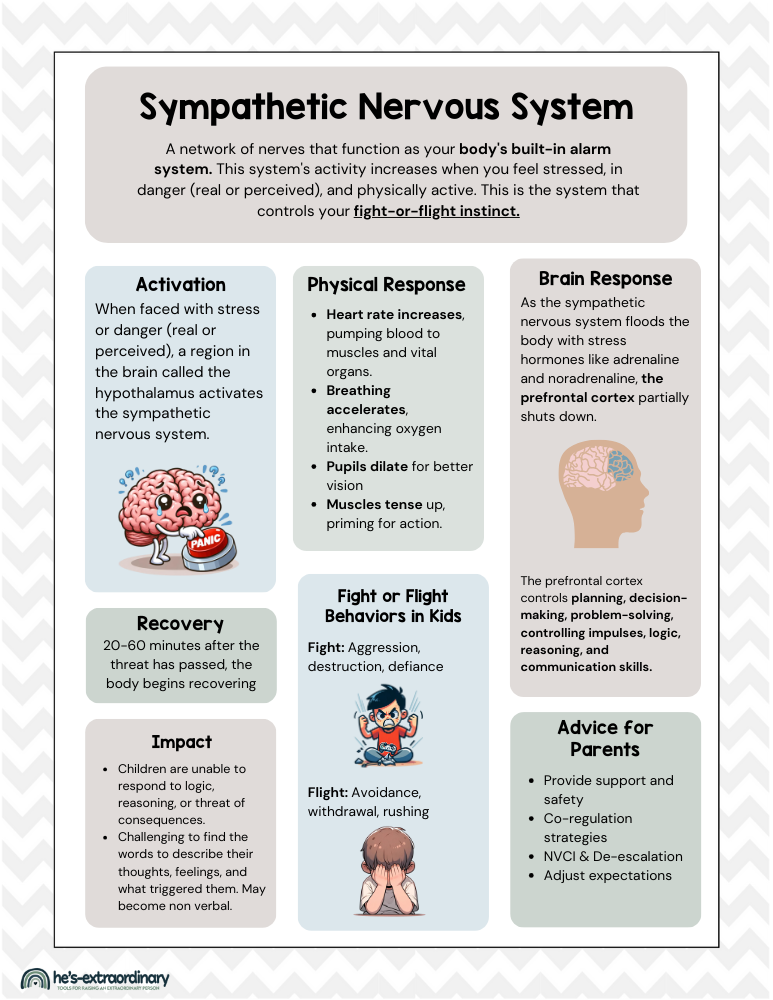
It’s like having an alarm system on your home to protect you from burglars, but it’s so sensitive that it goes off any time a bird lands on your roof.
(I have some free resources for helping kids (and parents) better understand fight or flight here. )
This is why, during times when the hindbrain is in control, it’s important to remain calm and ensure safety until the forebrain is back in control.
You can and certainly should set boundaries, communicate clearly, tell your child “no,” and guide them. You just need to wait until the functionality of the prefrontal cortex is restored if you want those things to actually be meaningful for your child.
Understanding the Point of No Return
When your child reaches the point of a full meltdown, it’s important to recognize there is no magic solution or quick fix to stop it instantly.
I know—as a parent, that’s not what you want to hear. It’s incredibly tough to watch your child struggle and not be able to immediately “fix” things.
But, at this stage, the best approach is simply to safely get through it together.
The de-escalation strategies outlined here aren’t about ending the meltdown instantly but about supporting your child compassionately through these difficult moments.
Using these strategies helps everyone stay safe, calm down more quickly, and recover afterward.
Remember: Reducing the frequency and intensity of meltdowns involves using a combination of proactive strategies to prevent meltdowns before they happen, teaching self-regulation skills to kids when they’re calm, and consistently applying de-escalation strategies.
Over time, this combined approach can lead to fewer and less intense meltdowns, benefiting both you and your child.
De-Escalation Strategies
Even with proactive strategies in place, meltdowns can still happen. The following strategies can help you safely navigate meltdowns by supporting your child effectively through their intense emotions.
Some of these techniques might initially feel like they’re telling you what not to do—but that’s because our instinctive responses can unintentionally escalate the situation despite our best intentions.
1. Do Not Try to Use Reason or Logic
When your child is having a meltdown, the logical part of their brain (the prefrontal cortex) isn’t functioning.
During a meltdown, the fight-or-flight instinct takes over, and the brain is flooded with adrenaline and cortisol, so they literally cannot access the part of their brain that thinks logically.
It may be tempting to try to reason with your child, but often, that will make them angrier.
Avoid saying things like, “I know you wanted me to pick you up from school, but I have to work late.” or “Your pink shirt is in the washer, so I can’t have it ready in time; that’s why you need to wear a different shirt.”
When the brain is engaged in fight-or-flight, there is a perceived threat. During that time, reasoning attempts are ineffective. Often, showing empathy will also make things worse.
Focus on reassuring your child that they are safe by staying calm and meeting basic needs.
Once your child has actually calmed down, they may respond to this kind of reasoning, but mid-meltdown, it won’t help.
2. Avoid Making Demands
Sometimes, too many demands can actually cause a meltdown in the first place, especially if your child has pathological demand avoidance. But regardless of the cause, avoid making more demands during dysregulated situations.
Demands include telling your child repeatedly to “stop,” “calm down,” or “snap out of it” isn’t going to make them stop or calm down or snap out of it. It doesn’t matter how nicely or assertively you ask.
Place all of your other expectations on hold temporarily. The only thing that matters in the present moment is helping your child calm down.
3. Don’t Yell To Be Heard Over A Screaming Child
If your child is having a meltdown, it’s best to maintain a calm voice.
Yelling makes you appear threatening and will not help de-escalate a meltdown.
Once the fight or flight instinct is activated, it’s important to understand that your child’s brain is perceiving a threat. They need reassurance that they are safe.
You may think, “My child knows I’d never hurt them.” Of course, they do.
But during these situations, your child isn’t thinking logically at all. Their brain is instinctually reacting, so anything that seems threatening will worsen the situation.
If your child is screaming, do not try yelling so they can hear you. Wait until they stop, and then speak to them calmly and empathetically.
4. Validate Their Feelings, Not Their Actions
Everybody has the right to feel a certain way about any given situation. One thing you never want to do is shame your child for how they’re feeling.
Giving validation to their feelings shows your child that you accept their thoughts, feelings, and sensations.
This shows your child that you’re on their side. Even if you don’t think they have a “reason” to be upset, they obviously are, so try to put yourself in their shoes.
Say things like, “It makes sense that you are mad right now,” Or, “If that happened to me, I would be so upset, too.”
Include a “because” when you validate instead of a “but” – this is part of a strategy known as emotion coaching. You can read more on that here.

For example: “It makes sense that you’re upset right now because you really wanted the orange cup, not the blue cup – and because it’s hard not to get what you want sometimes.”
You don’t want your child to feel shame for having emotions. We can learn a lot from emotions. When everyone is calm, you can guide your child to express their feelings differently next time.
5. Respect Personal Space
Everyone’s personal “bubble” is different, but regardless, that bubble gets bigger with heightened emotions.
Unless your child asks, keep back at least 3 feet from them. Do not try to touch them, hug them, or pick them up (unless they’re in danger).
In a heightened emotional state like a meltdown, feeling trapped or closed in by you can further escalate the situation.
6. Be Aware of Your Body Language and Facial Expressions
It’s important to appear calm and non-threatening throughout your child’s meltdown.
The best way to do this is by being mindful of your body language and facial expressions.
- Keep your facial expression neutral: Consciously check yourself and make sure you aren’t frowning, furrowing your brow, or clenching your jaw.
- Be intentional with your body language: Don’t cross your arms or put your hands on your hips. Avoid pacing, pointing your finger, or other large hand gestures. It’s best to keep your hands in front of your body in a relaxed position.
One of the biggest factors in de-escalation is parental emotional regulation.
7. Get on Your Child’s Level
Don’t stand over them, looking down at them as you talk. It gives off a vibe of superiority that isn’t helpful at the moment. It also can feel threatening.
If your child will sit, sit with them. If not, kneel so you’re at eye level with them when communicating. (Although it’s usually best to keep communication to a minimum).
You may even need to lay with them if they’re on the floor if that’s what they’re doing.
8. Distraction
This de-escalation strategy works best if it’s used early.
Try distracting your child from the current situation by offering them a favorite toy, a preferred calming activity, or showing them a funny video you think they would like.
This could mean suggesting a short walk or offering your child a break in a calm-down corner. These distractions also change their environment and may remove them from the trigger or help them to reset.
This technique doesn’t mean your child “gets away with” the behavior. Once they’re calm and more likely to respond with reason and logic, you can re-address the original issue, if appropriate.
9. Reflect on Your Child’s Wants and Needs
Reflective listening shows you are listening to their concerns, however poorly they are being communicated.
Say things like, “So you are saying you are upset because you really wanted your pink shirt today?” or ” You don’t want your Aunt to pick you up from school. Do I have this right?”
If you’re lucky enough to get a moment where your child says “YES!” to your reflection, it opens an opportunity for you to validate your child’s feelings then and help them calm down.
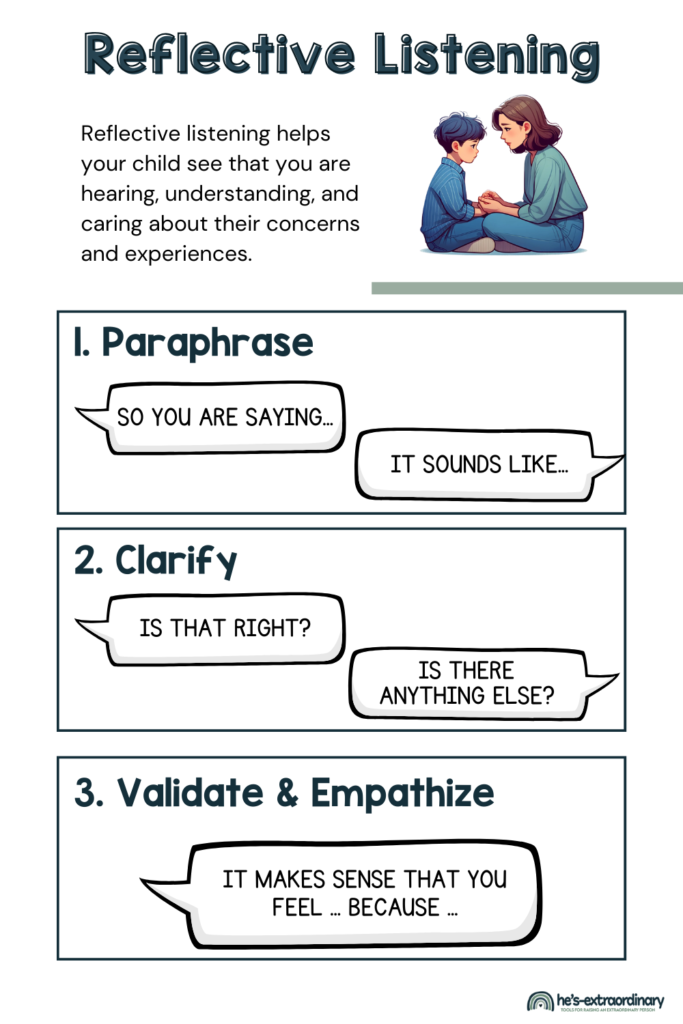
10. Acknowledge your Child’s Right for Refusal
Children can suddenly become a lot more likely to cooperate when they don’t feel like they are being “forced” to do something. This is especially true for children with pathological demand avoidance.
Acknowledge this right by saying, “You’re right, I can’t make you do …” then explain why you would like them to choose to do what is asked and provide a logical consequence.
For example, “You’re right; I can’t make you clean up your toys. However, we can’t play outside until they are put away.”
You’re allowed to set boundaries and allow them to choose. However, keep in mind that this strategy is only effective when used early. If your child is melting down, they won’t be responsive to logical consequences.
11. Answer Their Questions but Ignore Targeted Aggression
If your child asks a question during a meltdown, even if it’s asked inappropriately or rudely, provide a calm and concise answer.
However, ignore any aggressive statements they make towards you. For example, if your child yells, “You’re the worst mommy in the world!” do not respond or react.
Keep talking to a minimum, using short responses. Answer their questions and nothing more.
If your child regularly defaults to aggressive communication when they’re angry, this is a great communication printable to try (when they’re calm – not as a de-escalation technique): Assertive vs Aggressive Communication
12. Silence
Sometimes, total silence can help your child begin calming down.
Stop talking altogether to both your child and anyone else around you. I also try to take slow, deep breaths when I’m trying this strategy. Breathe deeply enough that it’s audible in the silence.
It helps me to remain calm and also models a healthy calming strategy for my children – even if they aren’t ready to use one.
13. Offer a Movement Break or a Walk
Getting moving is proven to reduce stress, help you calm down, and increase serotonin, the feel-good neurotransmitter.
During a meltdown, the fight or flight instinct is activated – movement like going for a walk can “trick” your brain into feeling that it’s chosen “flight” and help you start calming down.
Ask your child if they want to go for a quick walk or movement break. You can even try this 7-minute HIIT workout for kids or these animal-theme gross motor skill activity cards if your child is open to it.
14. Be Non-Judgemental
Regardless of the situation at hand, acting judgemental during a meltdown will only make things worse.
Avoid things like using sarcasm, dismissing your child’s feelings, blaming them, or treating them as unintelligent.
Also, avoid lecturing or trying to solve their problems for them at the moment. This conversation needs to come later when they’re calm again.
15. Decrease Stimulation
No matter what caused the meltdown, additional stimulation can contribute to more overload.
Minimize this stimulation by dimming lights, turning the TV down or off, and having other people leave the room if possible.
It’s also a good idea to have a safe, calming space where your child can go to remove themselves from the situation when they’re overstimulated.
16. Avoid Saying “No”
If your child is asking you questions, avoid saying the word “no” because it can instantly make things worse.
No is a trigger word for a lot of people.
Nobody likes to hear the word “no,” and when emotions are already heightened, it can make things even worse for a child.
Of course, I’m not suggesting you say yes to whatever they want. Simply offer more open-ended answers like “We can plan a time to do that” or “That’s something we can talk about when everybody is calm.“
17. Use Calming Visual Input
Certain visual input can be mesmerizing and help children calm down.
Try creating a calm-down bottle together to use when your child is upset, or use an LED light projector or a lava lamp.
18. Deep Breathing Exercises
The truth is, unless these skills are taught to your child when they’re calm, they aren’t going to work when they’re upset.
It takes a lot of practice and pre-teaching for your child to be able to self-regulate with deep breathing exercises. However, the work can pay off.
Eventually, with frequent practice, while calm, you will be able to prompt your child to do deep breathing exercises when they are upset or to model that breathing and have them imitate you.
If you can get your child to use this de-escalation technique in the moment, it works quite quickly. If not, this is something you can do together during the post-crisis depletion or recovery phase of the meltdown.
Read some tips about how to teach kids to do deep breathing correctly: here
This 5-minute bio-feedback activity (done when everyone is calm) is a great way to show your child how deep breathing helps you calm down; it’s called How low can you go?
All of these strategies won’t work on all children, and the ones that do work probably won’t work every time.
But, having a bank of de-escalation strategies to try is useful for parents who regularly encounter meltdowns.
As you try out these methods and learn how your child responds, you will find the best techniques for you. You may also want to take some time to read: 8 Verbal De-Escalation Techniques for Managing Challenging Behavior & Meltdowns.
Free Printable Poster
Download these de-escalation strategies as an 8.5 x 11-inch poster below. You can use this poster to display as a visual reminder or to pass out as a handout.
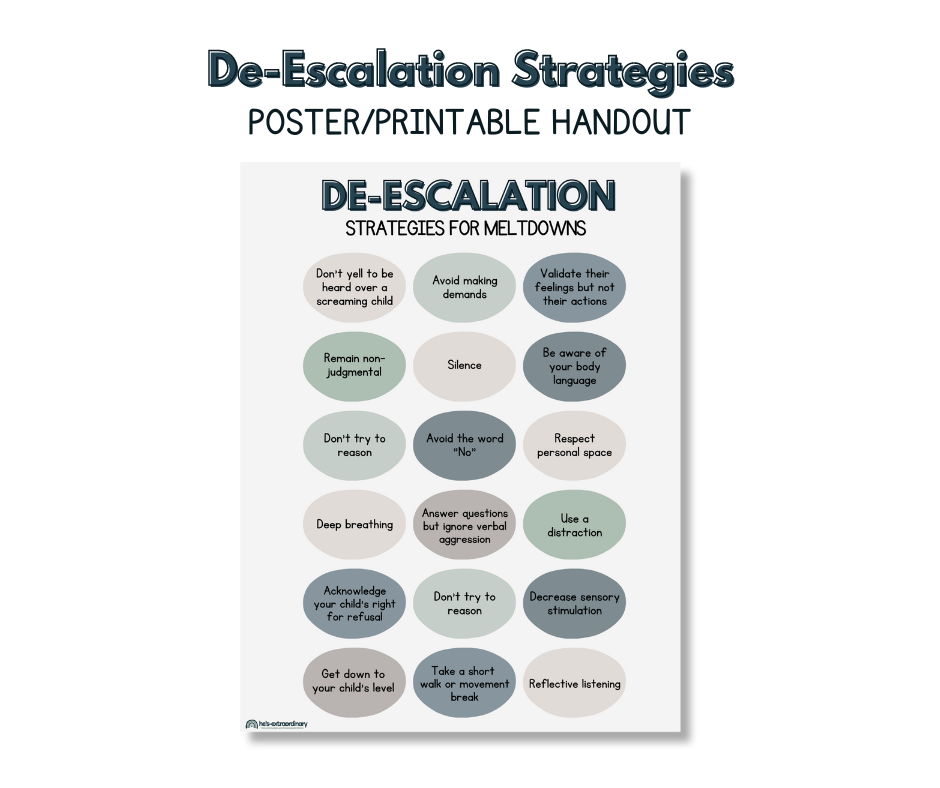
De-Escalation Strategies Poster
Printable 8.5 x 11-inch poster of de-escalation strategies.
Use it as a poster, handout, or visual reminder.


